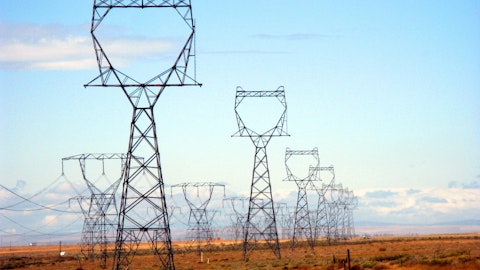Kevin Akers: Yes, again, I’ll reiterate what I said previously. There towards the last quarter, we saw some of the line locating requests drive down just a few percentage points in some of our jurisdictions. Even though here in Texas, we saw an 8% increase. So that’s what we were looking at there. That certainly reduced some of our compliance costs. Then again with some of our other compliance activity and timing of those sort of things, we think we’ve got a good handle on what the next year, the 3- to 5-year window looks like on planned O&M activity, compliance activity, those sort of things. So those were some of the drivers we were looking at that came out of the last quarter and allowed us to stay in that 3% to 3.5% range and at $780 million to $800 million O&M.
Christopher Forsythe: Yes. And Gabe, I’ll add to that. There’s a lot of compliance work that we still have to do as a utility. The rules continue to become more stringent. So we’re anticipating some of that in the 3.5%. A little bit to higher — a little bit higher inflation than we’ve had in the past, although it has moderated somewhat in the third and fourth quarters. And as a final reminder, with our annual mechanisms that we have in several of our jurisdictions, we had the opportunity to recover that fairly timely, generally within a year. So it shouldn’t be a significant drag if approved for those annual mechanisms as we anticipate.
Gabriel Moreen: Got it. And maybe if I can also ask in the context of becoming a cash taxpayer over the next couple of years. Is there anything you can do kind of as an offset, whether from a corporate level or from a regulatory standpoint, to offset maybe some of the cash impact there? And then maybe also bigger picture, just what you’re assuming sort of on interest rates and recoverability from a cost of capital standpoint, over the next couple of years given how dramatically rates have shifted, I guess, since the last 5-year uptake?
Christopher Forsythe: Sure. I’ll address the cash taxes first. First, we’ve got excess deferred taxes as I mentioned. That’s beginning to tail off kind of after a couple of years. The IRA for us expects we should kick in, in the mid part of the 5-year plan, and that’s predicated on just to the continued growth of the company. Fortunately, there aren’t a lot of levers for us to pull. It’s really a 15%, or you end up becoming a cash taxpayer as we begin to burn off some of the NOL shield that we have. And that’s been contemplated in our plan. So we knew going into this plan that we had either 15% or the fact that NOL shields were going to be becoming lower. So there’s not a lot of levers we can do. Our tax team is obviously looking at opportunities for tax planning strategies.
It’s too soon to say if there’s anything material that will come from that. But right now, we have conservatively estimated what will be a full cash — federal cash tax payer have in the middle part of our 5-year plan. With respect to interest rate costs, we certainly have reflected what we believe are current market conditions in the 5-year plan. I’ll also just remind you that we have the $900 million in hedges at a weighted average treasury cost of about 1.59%. That’s a significant portion of our anticipated FY ’25 needs and a fair amount of our anticipated FY ’26 need. So AMT will continue to look for opportunities to lock in some hedges, but given the higher elevated or where the interest rates are right now, it may not be as prudent or as attractive to do so as it was a couple of years ago, when rates were in the sub-2% range.
Kevin Akers: Yes. I just want to reemphasize that the plan does reflect, as Chris said, they’re us becoming a tax cash payer out in that time frame. So that’s all backed into the plan that’s out there.
Operator: Your next question comes from the line of Julien Dumoulin-Smith of Bank of America.



